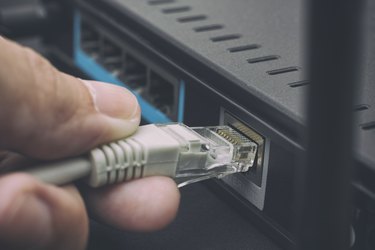
Engineers like to repeat the saying, "In theory, there's no difference between theory and practice, but in practice there is." That's useful to keep in mind in the world of tech, where things such as your internet speed and battery life never seem to be quite as good as the spec sheet says. It's also true of network cables: Category 5 Ethernet cables have a theoretical maximum length, and but in the real world, they probably need to be shorter.
What the Spec Says
Video of the Day
Everything to do with Ethernet is set out in a written standard published by the Institute of Electrical and Electronics Engineers, or IEEE. The full standard, 802.3, runs to several hundred pages, and unless you're an electrical engineer, it's a cure for insomnia. The part that lays out the Cat 5 cable length limit is section 14.1.1, which says the cable has to be able to carry a signal at least 100 meters without using a repeater. That's over 300 feet, which is more than enough for most homes and small offices, but it's not that simple.
Video of the Day
The Story Has a Twist
In the early days of networking, a long Ethernet cable was almost always a coax cable, like your TV cable, because it was shielded and protected the signal from outside interference. Those cables are bulky, hard to conceal and costly, which is why they're not used much anymore. Newer Cat 5 and Cat 6 cables use a type of overgrown telephone wire that is referred to as "twisted pair" cabling. On the inside, the flat cable is made up of four pairs of wires. Each pair is twisted together, which makes them somewhat resistant to outside interference. That's not nearly as effective as actual shielding, though, which is where things get interesting.
Here's the Catch
The problem is that the average home or office is packed with things that'll interfere with a signal, so your real-world Cat 5 length limit has more to do with your living room than with the IEEE standard. Power lines can interfere with the network signal, and so can radio signals, fluorescent lights, microwave ovens and the electric motors that run your refrigerator and furnace blower. A twisted pair wire acts as an antenna, and whatever it picks up needs to be filtered back out by your network. That takes resources, reduces the performance, and shortens the practical Cat 5 distance limit. You can probably still count on going a couple of hundred feet with a cable, but the real – admittedly unsatisfactory – answer is "it depends."
Testing Your Actual Cat 5 Length Limit
If you have a long Ethernet cable lying around, or if you can borrow one, you can find out whether it'll do the job in your actual location. Plug one end into your router and the other end into a laptop and check the network speed in the Network and Sharing Center or its Mac or Linux equivalent. If it's sharply below the 1,000 megabit/1 gigabit level, the cable is too long, and you're not getting the performance you should. In that case, take a close look at the cable. Cat 5 cables were originally designed for 10 Mbps networking, so for Gigabit Ethernet, you need the enhanced Cat 5e type. If your cable already is the Cat 5e type, and it probably is, then you need to upgrade to a Cat 6 cable to get the full distance you need.